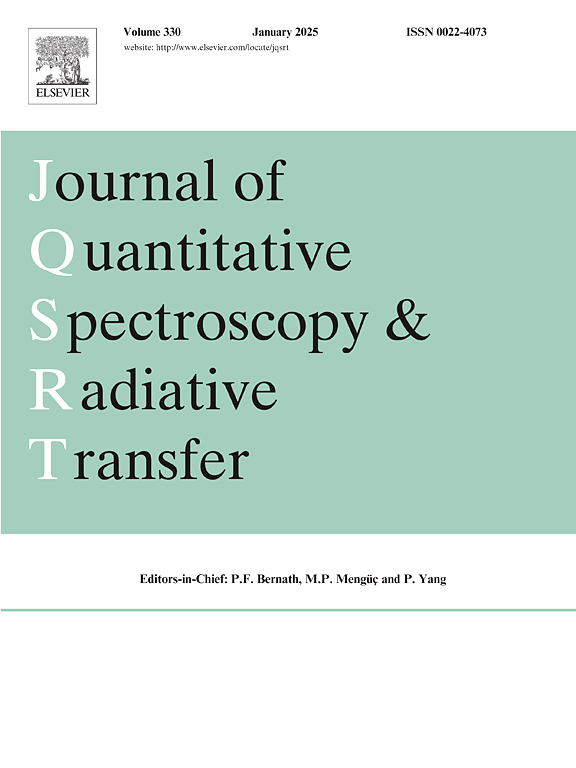New experimental measurements of the Collision Induced Absorptions of H2-H2 and H2-He in the 3600-5500 cm−1 spectral range from 120 to 500 K
IF 2.3
3区 物理与天体物理
Q2 OPTICS
Journal of Quantitative Spectroscopy & Radiative Transfer
Pub Date : 2024-10-30
DOI:10.1016/j.jqsrt.2024.109255
引用次数: 0
Abstract
The Collision-Induced Absorption (CIA) fundamental band of H2 has been studied in the 3600–5500 cm−1 spectral range for temperatures ranging from 120 to 500 K for both a pure H2 gas and a H2-He mixture. We used a simulation chamber called PASSxS (Planetary Atmosphere System Simulation x Spectroscopy) developed at INAF/ISAC which contains a Multi-Pass cell interfaced with a Fourier Spectrometer, aligned to reach an optical path of 3.28 m. The H2-H2 and H2-He binary absorption coefficients (BACs) have been derived for seven temperatures in the chosen range and provided in tabular form, including the unexplored high-temperature range above 300 K. We also calculated the integral of the H2-H2 and H2-He experimental BACs in the reduced 4000–5000 cm−1 spectral range, finding a linear trend with temperature in both cases. The integrals have also been computed with larger uncertainties for the whole band, in the total 3600–5500 cm−1 spectral range including the band's wings, partially affected by the water vapor absorption. The integrals calculated over the whole and reduced spectral ranges are collected in tables. In addition, we performed measurements with a H2-He mix for different mixing ratios to explore possible deviations from the linear combination of the BACs. The experimental BACs have been shown in comparison with Abel and Borysow's ab initio models for a temperature of about 400 K, resulting in a good agreement over almost the whole spectral range, with a maximum deviation around the main peak of the band. Data and models also show a good agreement in the linear trend of the integrated BACs with temperature, apart from the H2-H2 Borysow's BACs, which follow a quadratic trend. Finally, we resolved all the interference dips, which were not taken into account by the existing theoretical models.
在 120 至 500 K 的 3600-5500 cm-1 光谱范围内对 H2-H2 和 H2-He 碰撞诱导吸收的新实验测量结果
我们对纯 H2 气体和 H2-He 混合物的碰撞诱导吸收(CIA)基带进行了研究,其光谱范围为 3600-5500 cm-1,温度范围为 120-500 K。我们使用了 INAF/ISAC开发的名为 PASSxS(行星大气系统模拟 x 光谱)的模拟室,该模拟室包含一个与傅立叶光谱仪连接的多通单元,对齐后的光程为 3.28 米。我们还计算了在缩小的 4000-5000 cm-1 光谱范围内 H2-H2 和 H2-He 实验二元吸收系数(BAC)的积分,发现在这两种情况下,二元吸收系数与温度呈线性趋势。在 3600-5500 cm-1 光谱范围内,还计算了整个波段的积分,但不确定度较大,其中包括部分受水蒸气吸收影响的波段翼。表中收集了整个光谱范围和缩小光谱范围的积分计算结果。此外,我们还对不同混合比的 H2-He 混合气体进行了测量,以探索 BAC 线性组合的可能偏差。实验得出的 BAC 与 Abel 和 Borysow 在约 400 K 温度下的原初模型进行了比较,结果表明两者在几乎整个光谱范围内都很吻合,最大偏差出现在波段主峰附近。数据和模型还显示,除了 H2-H2 Borysow 的 BACs 呈二次方趋势外,其他综合 BACs 随温度变化的线性趋势也非常一致。最后,我们解决了现有理论模型没有考虑到的所有干扰凹陷问题。
本文章由计算机程序翻译,如有差异,请以英文原文为准。
求助全文
约1分钟内获得全文
求助全文
来源期刊
CiteScore
5.30
自引率
21.70%
发文量
273
审稿时长
58 days
期刊介绍:
Papers with the following subject areas are suitable for publication in the Journal of Quantitative Spectroscopy and Radiative Transfer:
- Theoretical and experimental aspects of the spectra of atoms, molecules, ions, and plasmas.
- Spectral lineshape studies including models and computational algorithms.
- Atmospheric spectroscopy.
- Theoretical and experimental aspects of light scattering.
- Application of light scattering in particle characterization and remote sensing.
- Application of light scattering in biological sciences and medicine.
- Radiative transfer in absorbing, emitting, and scattering media.
- Radiative transfer in stochastic media.

 求助内容:
求助内容: 应助结果提醒方式:
应助结果提醒方式:


